There is no sector more important than education. It serves as the building blocks of society. And access to effective and engaging education is a right every child and adult deserves.
However, like many other industries, education has faced significant change over recent decades.
The sector is still grappling with the post-pandemic world. Math and reading skills are still hindered by the disruption remote learning and school closures have caused. AI has also infiltrated the classroom, leading to efforts to restrict its use in exams and essays.
The success of change management in education hinges on effective execution. Robust planning and a holistic approach are necessary for success. This ensures teachers, students, and guardians are all on board.
This article will examine the role of change management in education. It will discuss its importance, key stages, and steps, as well as the best models and strategies for getting started.
What is change management in education?
Change management in education refers to the systematic process of preparing an educational institution for upcoming changes, developing an implementation plan, and executing the change effectively.
It involves strategies and approaches to facilitate smooth transitions during organizational transformations within schools, universities, or other educational settings.
Why is change management in education important?
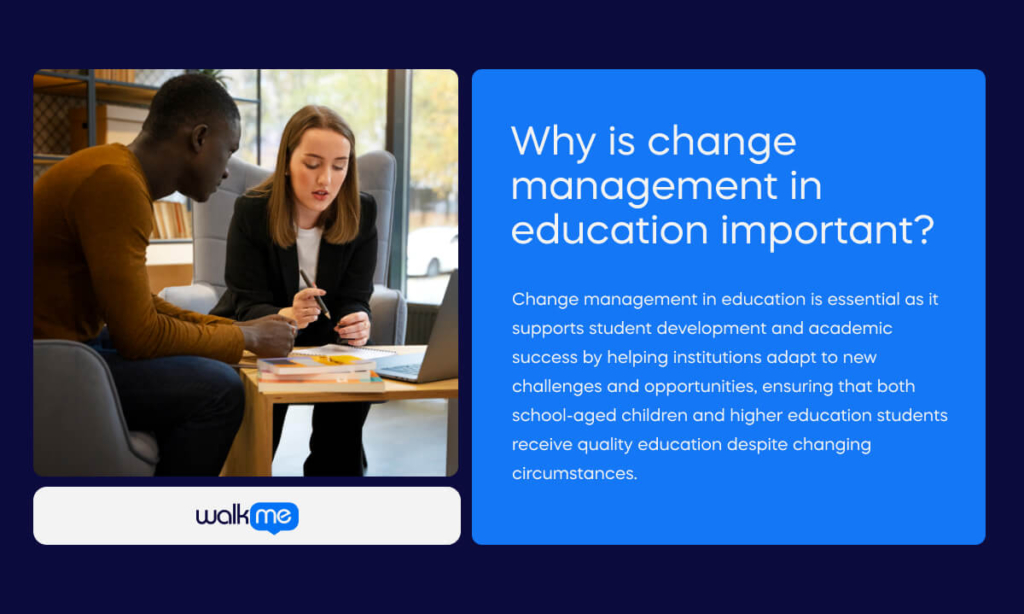
There are many reasons why managing change is crucial for successful education.
Change management in schools
The school years are the most important stages of our lives. They are the starting point, the foundation on which we build our lives.
Sage recently noted that these formative years are when we establish bonds, manage interactions, and begin to experience and process disagreements and struggles. Managing change effectively in these years is essential for a child’s development.
However, cognitive development is not the only factor. Grades are also important. The New York Times reported that one year of poor grades can significantly derail a high school student’s prospects. Change management is key to mitigating this issue.
A recent study on teaching styles in schools, surveying 540 teachers across over 100 secondary schools, concluded that successful leadership focuses on continual school improvement.
In other words, great teachers drive change. The study also highlighted that strong leadership, involving curriculum supervision and timetable management, is associated with academic success.
Change management in higher education
Although it may not be the path everyone takes, higher education is crucial for a functioning society. It equips individuals with skills needed for evolving labor markets, driving innovation and economic growth.
However, students in higher education are burdened with mammoth debt, especially since the early 2000s. Since 1980, consumer prices have quadrupled, but tuition has increased 16-fold. The rise in tuition has been matched by a surge in student loan debt, currently at $1.6 trillion across the US.
Student debt shouldn’t be surprising, though today’s high rates need attention. After all, colleges and universities are businesses. And for students to receive the education they’re paying for, they must adapt. Effective change management should be a pivotal part of their strategy, from employees to students.
According to the Mohammed Bin Rashid University of Medicine and Health Sciences Research, universities that fail to “adapt existing models to match the intricacies of the environment” could face significant setbacks.
What are the key stages of change?
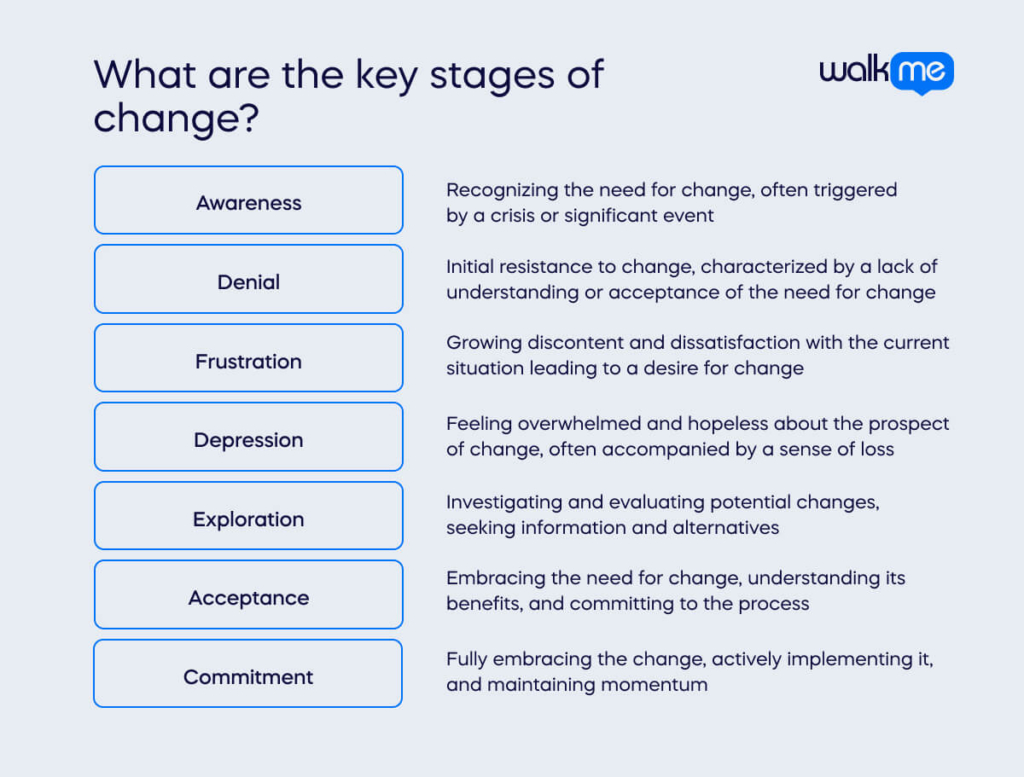
It’s important to understand the process to effectively manage change in education. It’s not a one-step process. Below are the key stages typically involved when enacting new change.
- Awareness: Recognizing the need for change, often triggered by a crisis or significant event.
- Denial: Initial resistance to change, characterized by a lack of understanding or acceptance of the need for change.
- Frustration: Growing discontent and dissatisfaction with the current situation leading to a desire for change.
- Depression: Feeling overwhelmed and hopeless about the prospect of change, often accompanied by a sense of loss.
- Exploration: Investigating and evaluating potential changes, seeking information and alternatives.
- Acceptance: Embracing the need for change, understanding its benefits, and committing to the process.
- Commitment: Fully embracing the change, actively implementing it, and maintaining momentum.
What are the key steps to managing change in education?

Leaders should adhere to the following steps to ensure that change management in education is successful.
Gathering key information and preparation
Every successful change management strategy hinges on preparation. And change management in education is no different.
To make the proposed change, start by analyzing its impact. This includes students, teachers, staff, parents, and the community. The analysis should assess the positive and negative effects.
Gathering data to demonstrate why the current state needs to change, and the benefits of the new approach will be essential. The data will justify the switch, highlight the new strategy’s advantages, and ensure a full understanding of its effects.
It’s important to prepare for potential resistance. Anticipating stakeholder resistance and developing targeted strategies to address objections, concerns, and resistance through training and communications is key.
Finally, draw up a comprehensive roadmap for a change management strategy. This entails documenting a clear, comprehensive plan comprising defined phases, activities, timelines, roles, and deliverables. For top results, incorporate mechanisms for tracking progress, adjusting approaches, and celebrating milestones.
Execution of change in education
Once the preparation is down, it’s time to enact the change. Communication is pivotal in this stage. It fosters awareness of the change, knowledge of results and reasons, and encourages reinforcement.
Ensure a clear definition of the change vision and relentless communication with stakeholders. Tailor communication plans for different stakeholder groups. Communication strategies will vary depending on the audience. Make sure to take this into account, whether it’s directed toward teachers, parents, or students.
Celebrating small, early successes is another crucial way to execute change management in education. It can assist in building momentum and buy-in for larger changes. According to Forbes, quick wins are an effective tool for managing change. They provide a workforce with a taste of success and set the stage for future accomplishments.
Reinforcing the change in education
The final stage of change management in education is reinforcement. After all, a change management strategy is only successful if it sticks. Maintaining the change can be as challenging as implementing it initially. Fortunately, there are effective strategies to ensure that the change endures.
Prioritize regular check-ins and offer support as needed throughout execution. Providing ongoing support, coaching, and opportunities to discuss challenges helps sustain new practices.
Establishing feedback loops is invaluable. Don’t underestimate the power of collecting data and surveys. Gathering input from teachers, parents, and students allows for flexibility, making it easier to identify issues and adjust approaches accordingly.
Focus on monitoring the change process with a fine-tooth comb, evaluating every stage. Establish robust monitoring mechanisms to track progress toward goals, ensuring data-driven adjustments based on evaluations.
What are the best models for managing change in education?
Change management in education can be daunting, but luckily, there are a range of models to follow to establish change effectively.
Lewin’s Model
Lewin’s Model for change management in education involves three stages: unfreezing, changing, and refreezing.
Unfreezing prepares stakeholders for change by creating urgency. Changing implements the desired transformation through training and addressing resistance. Refreezing solidifies the change by reinforcing new behaviors until they become institutionalized.
This systematic approach guides educational institutions through unfreezing old mindsets, introducing new practices, and embedding changes into the organizational culture.
The McKinsey 7-S Framework
The McKinsey 7-S Framework provides a holistic approach to managing change in education. It examines seven interdependent elements: strategy, structure, systems, shared values, skills, style, and staff.
The framework aligns these elements to identify gaps, create action plans, and implement changes effectively. It stresses shared values, continuous communication, and addressing all aspects of the organization for sustainable change management in education.
Kotter’s 8-Step Process
Kotter’s 8-Step Process revolves around multiple factors. However, unlike other models, this framework focuses on the following incremental stages:
- Create urgency
- Form a guiding coalition
- Develop a vision
- Communicate the vision
- Empower action
- Achieve short-term wins
- Consolidate gains
- Anchor the changes
While comprehensive, the model is not a one-size-fits-all. It should be adapted to the specific context and culture of each educational setting.
The ADKAR Model
The ADKAR Model is another strategy that provides a structured approach to change management in education. It focuses on five key goals:
- Awareness of the need for change
- Desire to support it
- Knowledge of how to change
- Ability to implement new skills and behaviors
- Reinforcement to sustain the change
The model stresses building change through clear communication. It provides training for new knowledge and uses reinforcement mechanisms like rewards and feedback to institutionalize changes over time.
Nudge Theory
Nudge Theory suggests making small environmental changes to subtly influence people’s behavior in a desired direction without restricting freedom of choice.
In education, nudge theory involves designing nudges to encourage positive behaviors like increased engagement, better study habits, or adopting new teaching methods among students and teachers.
What are the top strategies for implementing change in education?
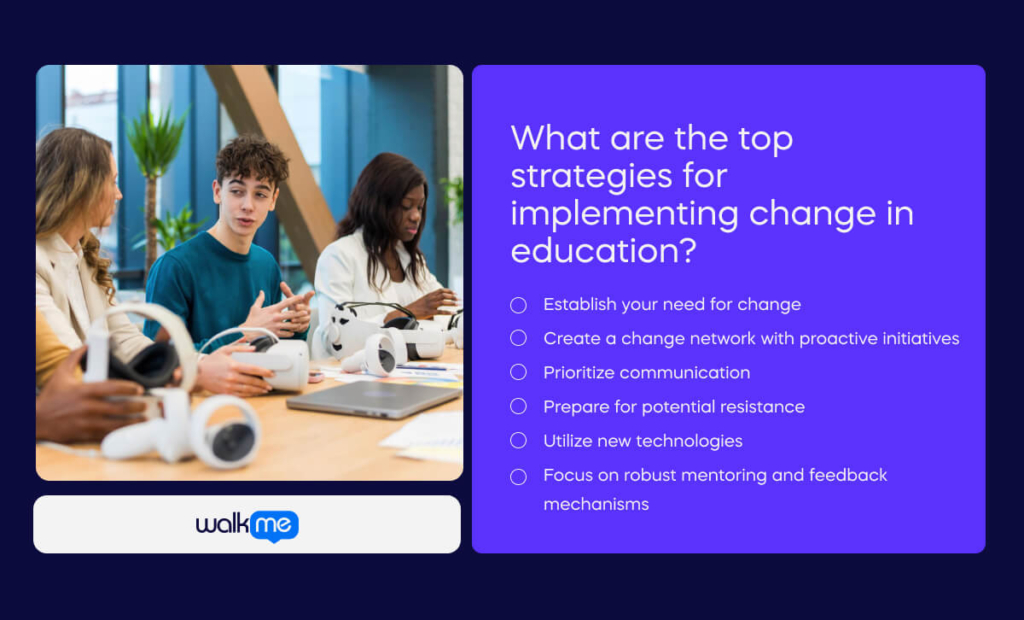
While understanding the key stages and models of change in education is important, successfully implementing change is crucial. Here are the top strategies for successful change management in education.
Establish your need for change
Change management in education hinges on purpose, making it crucial to establish the need for change. Start by assessing the educational institution’s current challenges and identifying how the change will address these issues.
Resistance often stems from a failure to recognize the need for change. Leaders can mitigate resistance effectively by establishing the need for change with measurable and objective goals.
Create a change network with proactive initiatives
Establishing a clear network with designated roles and proactive initiatives is essential for implementing change correctly.
Precision is key. While it may be tempting to approach new change strategies with all guns blazing, change is only effective with an engaged and well-coordinated network.
Ensure your change implementation plan accounts for every individual involved, including parents, students, teachers, and staff. Developing initiatives to celebrate small wins and reward proactive actions in change is also valuable.
Prioritize communication
Communication is another key to solving the puzzle of change management in education.
Early communication can reduce pessimism and uncertainty, minimizing rumors and resistance to change. Leaders of educational institutions must predict the outcome of the change and ensure every employee understands why and how the change is implemented.
Effective communication involves a two-way conversation across all levels. A study on public sector organizations highlights the need for regular and effective communication to reduce uncertainty and resistance during change management.
Communication must be clear, authentic, and genuine. The communication plan must be integral to the change plan, addressing how, what, when, and why from the people’s perspective.
Prepare for potential resistance
Resistance to change is likely and should be anticipated. It is a normal human response, even to positive changes, due to comfort with the status quo and fear of the unknown. Therefore, it’s important to expect resistance and proactively address it.
To effectively decrease change management resistance, target groups and individuals most likely to resist.
These may include those highly invested in the current way of working and those who created the existing processes. It’s also best to enlist senior leaders as active and visible sponsors of the change.
Utilize new technologies
Utilizing new technologies is essential for effective change management in education.
Technology has long been part of teaching. But, the pandemic and the shift to remote learning have made it more important than ever.
Digital tools can assist change management in many ways. They streamline documentation, increase transparency, improve communication across departments, and more.
Technology can also help with upskilling staff. Training programs, interactive workshops, coaching sessions, user forums, and other tools can decrease the likelihood of digital friction.
Focus on robust mentoring and feedback mechanisms
Leaders of change should focus on adopting a robust system for mentoring and evaluation too.
Mentoring should provide personalized guidance and support, helping individuals develop skills and knowledge tailored to their specific needs and goals.
These programs also make teachers, students, and parents feel valued and connected within the educational institution, enhancing retention and mitigating resistance.
Evaluation also is essential for effective change management. Regular assessments help identify strengths and weaknesses, enabling adjustments to mentorship programs and ensuring they remain relevant and impactful.
Feedback loops should also be implemented. They help educational institutions understand behaviors and outcomes by providing a mechanism for sharing information, fostering improvement, and quickly adapting to changing circumstances.
What are the benefits of managing change in education?
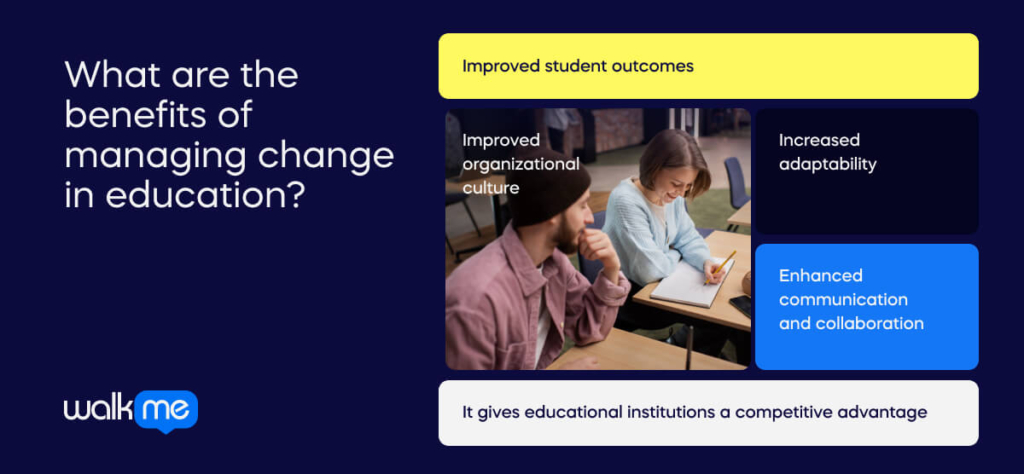
There are many benefits to successful change management in education. Here are a few.
Improved student outcomes
The core benefit of successful change management in education is the positive impact it can have on students.
Effective education is crucial. It increases the reputation of a school or higher educational institution and ensures that students are prepared for success in future endeavors.
Improved organizational culture
Effective change management in education can also improve an institution’s organizational culture. It builds trust and resilience across the workforce and helps create a shared sense of purpose.

Educational institutions are typically hierarchical. While this structure has its benefits, it also has drawbacks. Successful change management can help mitigate these limitations, creating a positive culture that supports ongoing improvement and innovation.
Increased adaptability
Change management helps educational institutions become more agile and responsive to evolving needs. The education sector has faced unprecedented changes in the past decade, from the impact of the pandemic to shifts in teaching methods.
Schools and universities need the agility to adapt to evolving challenges, now more than ever. By embracing a culture of continuous improvement, they can stay ahead of the curve and provide students with the most relevant and effective learning experiences.
Enhanced communication and collaboration
Another key benefit of managing change in education is its ability to foster communication and collaboration.
A good change plan can strengthen ties with all stakeholders. These include teachers, administrators, students, and the wider community.
Implementing new changes, such as digital transformation strategies, can also greatly enhance communication within educational institutions.
It gives educational institutions a competitive advantage
When it comes down to it, educational institutions operate like any other business. Schools and colleges compete with each other. They want higher grades and more students.
Staying current with the best educational practices and technologies is key to change management. It gives institutions a competitive edge.
What are the challenges of managing change in education?
Despite the benefits, there are also challenges to overcome. Here are a few of the common challenges that occur when managing change in education.
Communication and leadership
Communication and leadership strategies pose major challenges for enacting change in education. Effective management catalyzes the implementation of new strategies. If executed incorrectly, they can have a knock-on effect across the entire workforce.
Barriers to communication in education can reduce buy-in. In a recent study by Oak Engage, 29% of employees reported unclear communication regarding change within their organization. Similarly, 28% stated they did not receive the necessary information to understand the change.
However, senior leadership shouldn’t be the only key driver of change in education. According to a recent report by Prosci, 70% of employees prefer to receive personal impact messages from their supervisors, whereas only 50% prefer messages from business leaders such as CEOs or presidents.
Keep this in mind when enacting change across educational institutions. Leaders should oversee change strategies, but department heads or teachers’ supervisors may be more effective at communicating.
Resistance
Resistance is another key challenge for change management in education, as it is in many businesses.
Lack of support for change is more common than some may think. According to a report by Gartner, only 38% of employees were willing to support organizational change in 2022.
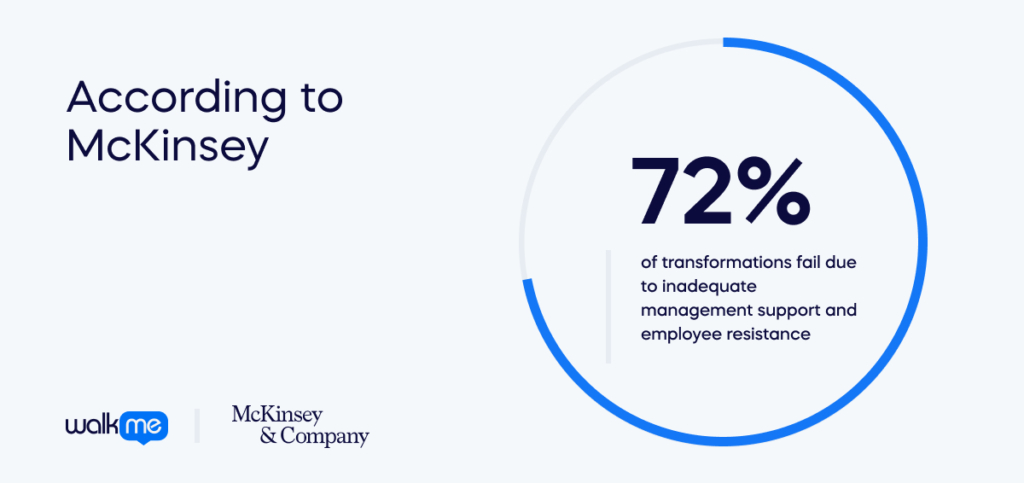
This has a tangible impact on the success of change management. According to McKinsey, 72% of transformations fail due to inadequate management support and employee resistance.
Resistance can result from various factors. These include a lack of clear communication and leadership, too much change and stress, and not enough support and training.
Change oversaturation
Too much change can also pose a challenge for managing change in education. If too many changes are enacted simultaneously, employees can feel overwhelmed and stressed, leading to a lack of buy-in and resistance.
This trend has occurred across various sectors and has become more prominent post-pandemic. According to a report by Capterra, 71% of employees reported feeling overwhelmed by the amount of change at work during the COVID-19 pandemic.
Remember this when enacting change across a school or higher educational institution. To mitigate the challenge of change oversaturation, focus on small, measurable goals and celebrate them accordingly.
It’s wise to consider the big picture. While it can be tempting to enact huge changes all at once, planning for smaller incremental changes to achieve goals over a longer period can be more effective in the long run.
Culture
The culture of an educational institution can be another significant barrier to enacting change.
Schools and universities, being typically hierarchical, can face challenges in employee engagement and buy-in for adopting change strategies. According to a CEB Corporate Leadership Council report, 28% of employees resist change because top-down communication makes them feel angry and anxious.
Education leaders should focus on improving the culture throughout the organization, from teachers to students. Creating a culture across the workforce that focuses on trust is key.
Research has shown that mistrust in the organization is one of the driving factors for resistance, cited by 41% of respondents. This was followed by a lack of awareness of the reason for change at 39% and fear of the unknown at 38%.
Lack of time and resources
Lack of time and resources is another key challenge hindering change in education. Schools in the US are still facing issues, even after the pandemic has ended.
According to a report by USA Today, there has been an increase in student and teacher absences, staff shortages, and struggles to fill job roles. This puts extra pressure on leaders to enact change in education successfully.
Traditional industries, like education, often lag in digital transformation strategies. While the success rate of adopting digital change in tech-savvy industries stands at just 26%, for traditional industries like education, it’s reported to be only between 4 and 11%.
Future-proofing learning: Change management in education
Schools and higher educational institutions face an uphill battle when enacting change across their organization. This reflects a wider trend seen across various industries. According to a WTW study, in 2023, only 43% of employees say their organization is good at managing change, down from nearly 60% in 2019.
While trust in change management is dropping, the need for adapting to change is growing. Education has changed drastically over the past decade. The rise of remote learning, cultural shifts, and new technology have disrupted the classroom.
Now more than ever, leaders need to enact change effectively. While this is no easy task, effective change management in education is possible with diligent planning and execution.
Engaging the workforce is key. This is done through clear communication, new tech, and a clear roadmap. These steps can help reduce resistance and ensure students get a top education in a changing world.

Common Questions
Success can be assessed through metrics like stakeholder engagement levels, achievement of defined objectives, and improvements in student outcomes. Regular feedback and performance data help in evaluating the effectiveness of change efforts.
Engaging stakeholders—teachers, students, parents, and staff—ensures diverse perspectives are considered, fostering buy-in and reducing resistance. Inclusive participation leads to more effective and sustainable change
Effective leadership provides clear vision, direction, and support during transitions. Leaders facilitate communication, address concerns, and motivate stakeholders, which are essential for successful implementation of change.
Addressing resistance involves transparent communication about the reasons for change, providing adequate training, and involving staff in the decision-making process. Recognizing and addressing concerns helps in easing the transition.
Sustaining change requires continuous support, regular evaluation, and adaptability. Establishing a culture of continuous improvement and providing ongoing professional development are key strategies.

